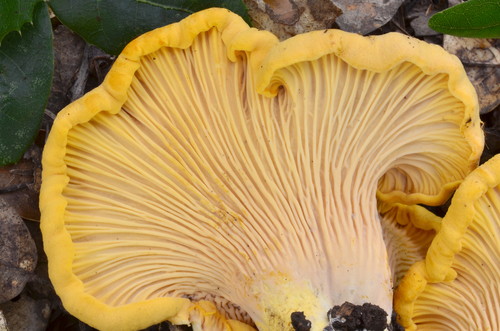chanterelles
CantharellusSummary 6
Cantharellus is a genus of popular edible mushrooms, commonly known as chanterelles/ˌʃæntəˈrɛl/, a name which can also refer to the type species, Cantharellus cibarius. They are mycorrhizal fungi, meaning they form symbiotic associations with plants, making them very difficult to cultivate. Caution must be used when identifying chanterelles for consumption due to lookalikes, such as the Jack-O-Lantern species (Omphalotus olearius and others), which can make a person ve
Habitat 7
Cantharellus species are found throughout the world in association with mycorrhizal host plants, including Africa, Europe, Asia, North America, South America, and Australia.
Chanterelles are associated with either conifers or hardwood trees, depending on species. They are often found with oaks in California and Texas. In Scotland, chanterelles grow in mixed forests of silver birch and Scots pine, especially when the forest has plenty of moist, mossy undergrowth. In Fife they are common under beech. They are usually (but not always) found in the same places as wild blueberries. In Spain they associate with sweet chestnut. A walk in the woods after rain should prove fruitful from late July through the Autumn. In the coastal forests of Washington and British Columbia they are often found in damp, mossy riparian zones in the vicinity of hemlock and western red cedar trees.
Similar species 7
The False Chanterelle (Hygrophoropsis aurantiaca) has finer, more orange gills and a darker cap. It is edible, but typically a culinary disappointment. The very similar Jack O'Lantern mushroom (Omphalotus olearius) and its sister species (Omphalotus olivascens) are very poisonous, though not lethal. They have true gills (unlike chanterelles) which are thinner, have distinct crowns, and generally do not reach up to the edge. Additionally, the Jack-O-Lantern mushroom is bioluminescent and grows on wood - possibly buried - whereas Cantherellus species grow on the ground. Species in the genera Craterellus, Gomphus, and Polyozellus may also have a somewhat chanterelle-like appearance.
Sources and Credits
- (c) Christian Schwarz, some rights reserved (CC BY-NC), uploaded by Christian Schwarz
- (c) Alan Rockefeller, some rights reserved (CC BY), uploaded by Alan Rockefeller
- (c) Damon Tighe, some rights reserved (CC BY-NC), uploaded by Damon Tighe
- (c) Linda Gail Price, some rights reserved (CC BY-NC), uploaded by Linda Gail Price
- (c) Danny Newman, some rights reserved (CC BY-NC-SA), uploaded by Danny Newman
- Adapted by Will Kuhn from a work by (c) Wikipedia, some rights reserved (CC BY-SA), https://en.wikipedia.org/wiki/Cantharellus
- (c) Wikipedia, some rights reserved (CC BY-SA), https://en.wikipedia.org/wiki/Cantharellus









